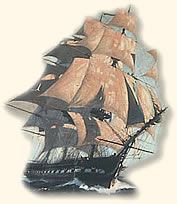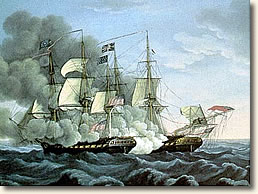|
"Old Ironsides" Earns its Name, 1812
On the afternoon of August 19, 1812 a mortal combat took place between the USS Constitution and the British frigate Guerriere 750 miles off the coast of Massachusetts. Barely fifty yards apart; each ship fired its twenty-two cannon point-blank into its opponent. The barrage from the British frigate seemed to be having little effect, however, as its cannon balls bounced off the Constitution's rugged oak sides. Seeing this, one of the Constitution's crewmen shouted: "Huzza, her sides are made of iron!" The Constitution's nickname was born.
 |
| Old Ironsides |
Commissioned in 1797, the Constitution was one of the first six ships of the fledgling U.S. Navy. In 1803 she led the squadron of American warships dispatched to the Mediterranean to subdue the Barbary Pirates of Northern Africa who were harassing America's trade ships in the area.
When war erupted between Great Britain and America in 1812 the Constitution took the offensive, bringing the battle to the enemy. In addition to destroying the Guerrierre, she also destroyed the British frigate Java off the coast of Brazil. Her exploits lifted the morale of the American people and elevated the status of the new nation's naval power.
Sailing off the American coast on August 19, 1812 a lookout aboard the Constitution spied the faint image of a sail on the distant horizon. The Constitution's commander, Captain Isaac Hull, ordered the crew to unfurl all the ship's sails and give chase. Within an hour the distance between the two ships had been shortened enough to allow the Captain to confirm that his prey was a British frigate.
The Captain ordered an attack. The crew responded with cheers. In a letter written to Secretary of the Navy, Captain Hull describes what happened as the Constitution continued to close with its enemy:
"As we bore up, she hoisted an English Ensign at the mizzen gaff, another in the mizzen shrouds, and a Jack at the fore, and mizzen top gallant mast heads. At 5 Minutes past 5 P.M. as we were running down on her weather quarter, she fired a broadside but without effect the shot all falling short. She then wore and gave us a broadside from her port guns, two of which shot struck us but without doing any injury.
At this time finding we were within gunshot...The enemy continued wearing, and
maneuvering for about 1/2 of an hour, to get the wind of us. At length finding
that she could not, she bore up to bring the wind on the quarter and run under
her topsails, and jib. Finding that we came up very slow, and were receiving
her shot without being able to return them with effect, I ordered the main
top gallant sail set, to run up alongside of her.
At 5 Minutes past 6 P.M. being alongside, and within less than pistol shot, we commenced a very heavy fire from all our guns, loaded with round, and grape, which was done with great execution, so much so that in less than fifteen minutes from the time, we got alongside, his mizzen mast went by the board, and his main yard in the slings and the hull and sails very much injured, which made it difficult for them to manage her.
 |
| The Battle |
At this time the Constitution had received but little damage, and having more sail set than the enemy, she shot ahead. On seeing this, I determined to put the helm to port, and oblige him to do the same, or suffer himself to be raked by our getting across his bow. On our helm being put to port the ship came to, and gave us an opportunity of pouring in upon his port bow several broadsides, which made great havoc amongst his men on the forecastle and did great injury to his fore rigging and sails.
The enemy put his helm to port, at the time we did, but his mizzen mast being over the quarter, prevented her coming to, which brought us across his bow, with his bowsprit over our stern. At this moment I determined to board him, but the instant the boarders were called for that purpose, his foremast and mainmast went by the board, and took with them the jib boom, and every other spar except the bowsprit.
On seeing the enemy totally disabled, and the Constitution received but little injury, I ordered the sails filled, to haul off, and repair our damages and return again to the action, not knowing whether the enemy had struck, or not. We stood off for about half an hour, to repair our braces, and such other rigging as had been shot away, and wore around to return to the enemy. It being now dark, we could not see whether she had any colors flying or not, but could discover that she had raised a small flag staff or jury mast forward.
I ordered a boat hoisted out and sent Lieutenant Reed on board as to see whether she had surrendered or not, and if she had to see what assistance she wanted, as I believed she was sinking.
Lieutenant Reed returned in about twenty minutes, and brought with him James Richard Dacres Esq. Commander of his Britannic Majesty's Frigate the Guerriere, which ship had surrendered to the United States Frigate Constitution. "
References:
Captain Hull's account appears in: Grant Bruce, Isaac Hull, Captain of Old Ironsides (1947, reprinted in Angle, Paul The American Reader, 1958); Forester, C.S., The Age of Fighting Sail; the Story of the Naval War of 1812.
How To Cite This Article:
""Old Ironsides" Earns its Name, 1812", EyeWitness to History, www.eyewitnesstohistory.com (2006).
|






